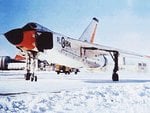FLYBOYJ
"THE GREAT GAZOO"
I've been wanting to put this out there for some time, I'm sure all of our Canadian friends will enjoy this one. The CF-105 was supposed to be an innovative fighter aircraft in it's day. Fast, sleek, it had all the makings of your typical 1950s interceptor. At the time it was being developed, other aircraft like the F-4 Phantom, F-106 and the BAe Lightning were also blooming as well. My time in Canada, many enthusiasts I met made the -105 this "super jet" and even by today's standards. I always liked her, but let's face it, she carried the doctrine of the 1950s. I think an aircraft like an F-5 would of flown rings around her in a dogfight, but then again that wasn't her mission...Or maybe it would of been?!?
PM Diefenbaker killed 90% of the Canadian aircraft industry with his decision, but let's imagine things were different. If built, how do you think her mission would of changed? Would a gun been installed like on the F-106? How long would she of lasted in service and was she really cranked up to what she was supposed to be?
PM Diefenbaker killed 90% of the Canadian aircraft industry with his decision, but let's imagine things were different. If built, how do you think her mission would of changed? Would a gun been installed like on the F-106? How long would she of lasted in service and was she really cranked up to what she was supposed to be?


